The beautifully tranquil Wye Valley was visited towards the end of the 18th century by artists and poets such as JMW Turner and William Wordsworth.
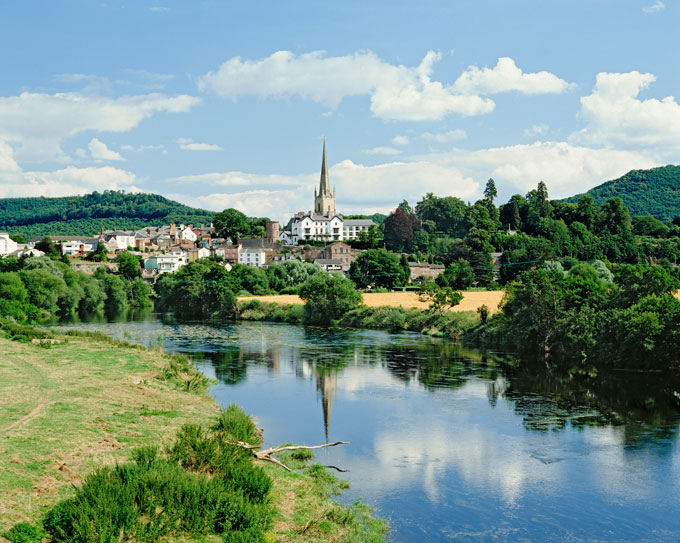
The railings on Old Wye Bridge at Chepstow have a story to tell. From the quay on the River Wye, you can see that they are divided midstream, with Monmouth shaped in wrought iron lettering on one side, Gloucester on the other. Here in border country, a unique history can be found on either side of the river.
On the Chepstow side is Wales, flying the Welsh Dragon flag, while across the bridge lies England and the Royal Forest of Dean in Gloucestershire. Peaceful now, this beautiful section of the Lower Wye has been the scene of many fierce battles between the Welsh tribes, who considered themselves the true British, and the Anglo-Saxon and Norman conquerors of England, who sought to dominate them.
The stark battlements of medieval Chepstow Castle are an impressive reminder of these times, guarding the entrance to the Wye from the top of sheer cliffs above the river. Although in ruins now, the castle remains a focal point of this attractive walled town. It was built in 1067 by the Normans as a statement of power to intimidate the undefeated Welsh, a year after William the Conqueror’s victory over the English at Hastings.
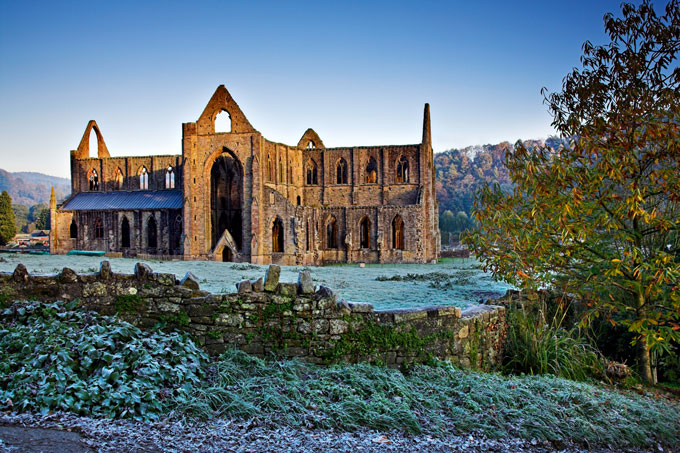
Chepstow Castle has changed hands many times, most latterly between Royalists and Parliamentarians during the English Civil War. On the English side of the river, a few miles north, is Wintour’s Leap, a far-reaching viewpoint on top of high cliffs over a particularly sinuous meander in the river. According to local myth, Sir John Wintour, a Royalist, escaped capture by leaping into the Wye below and swimming to safety.
There is a fabulous viewpoint looking towards Wintour’s Leap from the Welsh side at ‘Eagle’s Nest’. You can see over Lancaut Nature Reserve all the way to the River Severn, a scene that the Romantic poet Coleridge described as having “the whole world imaged in its vast circumference”. To get there, follow the road through the woods from Chepstow Racecourse and you’ll discover a delightful picnic spot under the trees at Wyndcliff.
The Wye Valley covers a 40-mile stretch of the river from Chepstow to Ross-on-Wye, which includes the counties of Monmouthshire, Gloucestershire and Herefordshire. The area was officially designated an Area of Outstanding Natural Beauty in 1971. For most of its course, from its confluence with the Severn and the Bristol Channel below Chepstow, up to the prosperous county town of Monmouth, 30 miles away, then onward to Ross, the River Wye weaves a watery frontier between England and Wales, snaking its way through dramatic cliffs and wooded hills.
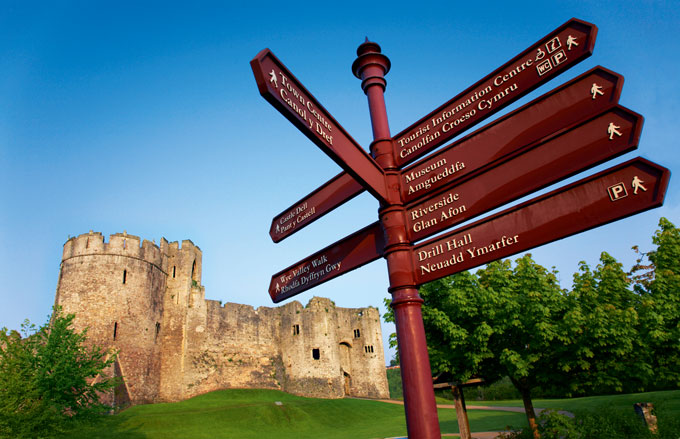
Territorial disputes have been making their mark on the Wye Valley for well over 1,000 years. In the 8th century, Saxon King Offa went to the extraordinary effort of building a dyke on the English side of the valley to protect his kingdom of Mercia from the Welsh. Offa’s earthworks begin at Chepstow and extend for a further 150 miles, still roughly marking the border between England and Wales today. Offa’s Dyke Path is a National Trail, 177 miles long, which begins at Sedbury Cliffs below Chepstow and runs through the Welsh Marches (as the England-Wales borderlands are known) all the way to the Welsh coast at Prestatyn.
Chepstow is a good place to watch the turning of the tide as treacherous currents sweep under the bridge. One minute the river is completely calm and covered in serene reflections, the next it is brown and seething. The water recedes to reveal steep glistening mud banks reaching as far up-stream as Bigsweir Bridge, 13 miles away.
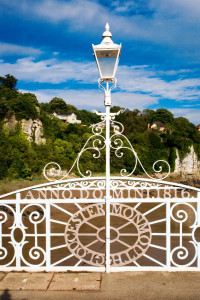
The Wye has the second largest tidal range in the world and is consequently seriously challenging to navigate. Nonetheless, 300 years ago Chepstow was a busy commercial harbour and the Wye Valley echoed with the sounds of heavy industry.
The area was one of the first British regions to industrialise, blessed with abundant water, wood and coal. Special flat-bottomed sailboats called ‘trows’ navigated the Wye from Hereford to Chepstow before heading to Bristol, servicing paper mills, wireworks and foundries along the way. They carried oak bark bound for Irish tanneries, and other local produce such as cider and hops. Gangs of men called ‘bow hauliers’, wearing wooden harnesses, were hired to drag the trows through shallow water. The opening of the Wye Valley Railway in 1876 killed the river trade but now the trains, too, have gone. Nature has long since reclaimed the old industrial sites and today the fun lies in re-discovering them.
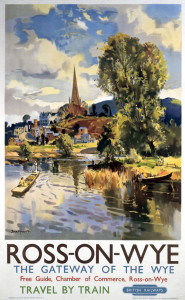
It was commercial traffic on the river that inspired Dr John Egerton, Rector of St Mary’s Church in Ross-on-Wye, to design his own boat in 1745. Sheltered from the elements by a canopy, he took friends on tours to enjoy the wonders of the Wye. The idea caught on and by 1808 eight boats took sightseers along the river, boarding at Ross – dubbed ‘the Gateway to the Wye Valley’ – Monmouth and Chepstow.
One such sightseer in 1770 was the Reverend William Gilpin, whose experiences were published in 1782 under the convoluted title Observations on the River Wye and Several Parts of South Wales etc., relative chiefly to Picturesque Beauty. “If you have never navigated the Wye”, Gilpin enthused, “you have seen nothing.”
His work was a resounding success, encouraging Victorians in their droves to take the Wye Tour. So it was that Dr Egerton’s modest desire to share the beauty of his surroundings, coupled with Gilpin’s guidebook, gave birth to tourism in Britain.
Amongst the early Wye Valley tourists was the Romantic poet William Wordsworth, who wrote in July 1798 of his yearning for the river in his poem Lines Composed a Few Miles above Tintern Abbey: “O sylvan Wye! thou wanderer thro’ the woods,/ How often has my spirit turned to thee!” Fellow Romantic JMW Turner painted the abbey several times and it remains one of the most popular attractions in the Wye Valley.
It was founded for the Cistercian Order in 1131 and the iconic ruined church dates back to the 14th century. Monks lived a peaceful out-of-the-way existence here on the Welsh banks of the Wye for 400 years until
3 September 1536, when King Henry VIII’s officials forced Abbot Wyche to surrender Tintern Abbey to the English Crown.
Devil’s Pulpit Viewpoint, looking over the abbey from the opposite side of the river, is one of the highlights of the Offa’s Dyke Footpath. A limestone pillar, with a commanding view over Tintern, stands alone on the cliff edge where the Devil is said to have taunted the monks below. Close by, an ancient yew grows out of the stone itself.
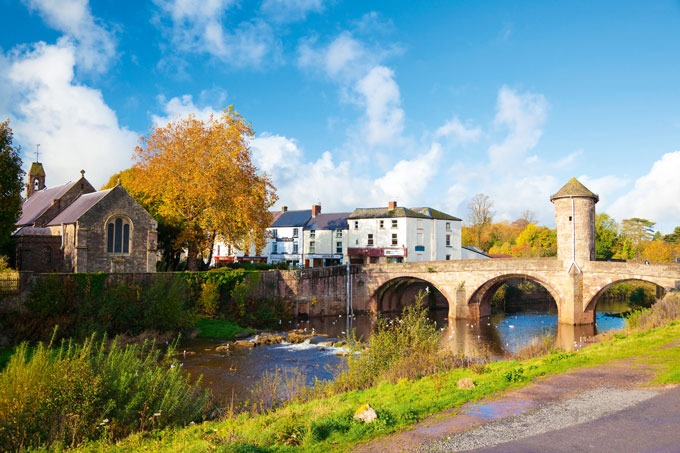
You can drop back down to the Wye by following the steep lane to the tranquil medieval village of Brockweir, famed for riverside walks and for its award-winning community shop that you will pass on the way down, crammed with local produce and information on all that’s going on in the Wye Valley. Sleepy Brockweir, however, was once a rather more boisterous place, infamous as a den of iniquity full of cider houses and brothels, serving trowmen, merchants and bow hauliers while they waited for the tide to turn.
The little red sandstone castle at nearby St Briavels dates from the 12th century too. This was the residence of the Warden of the Royal Forest of Dean, who protected the king’s game, and is also known as King John’s Hunting Lodge. King Edward I added the impressive twin-towered gatehouse in 1292 to defend a crossbow bolt factory housed inside the castle walls, but by the 15th century the Welsh had been subdued and the castle’s importance fell into decline. It was used as a debtors’ prison until 1842 and now is a youth hostel where guests sleep in the gatehouse prison.
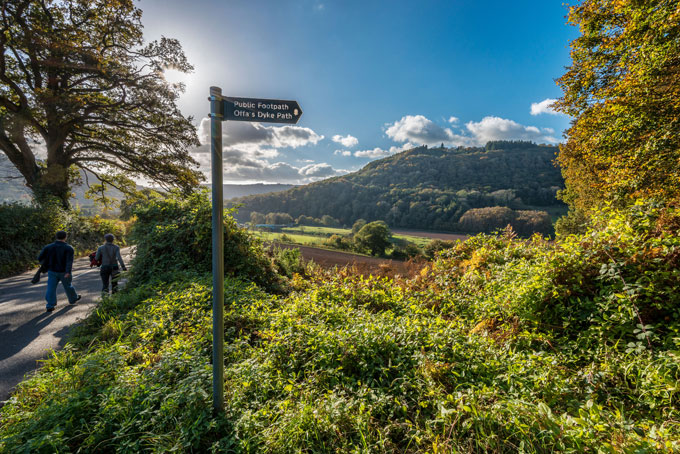
Another castle not be missed is at Goodrich, on the Wye near Ross, overlooking the rich red soil of Herefordshire. It has a fascinating history stretching back 1,000 years, with a cast including the English landowner Godric, who gave the castle his name; Richard ‘Strongbow’ de Clare, who built the 12th-century square keep that still stands today; and King Richard the Lionheart, who granted Goodrich to the famous castle builder William Marshal, in whose family’s hands it remained until 1245. The castle was hotly contested during the Civil War until the Royalists surrendered in 1646. Today you can see ‘Roaring Meg’, the war’s only surviving mortar, along with some of the most complete domestic medieval buildings of any castle in Britain.
Goodrich guards the entrance to Symonds Yat Valley, which offers a wide choice of outdoor activity and riverside pubs for relaxation. Head for Symonds Yat Rock, where the famous panorama over the Wye is always uplifting: you are standing on top of a 2,500-year-old Iron Age Hill Fort, some 500 feet above sea level. When mist covers the river, the summit of Yat Rock often peers above it. Then, magically, you can hear every splash in the river, every call of a bird below, as if it were right beside you.
Related articlesSunshine Isles |
Click here to subscribe! |





 © 2024
© 2024